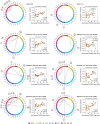Dynamic functional connectivity and its anatomical substrate reveal treatment outcome in first-episode drug-naïve schizophrenia
- PMID: 33980821
- PMCID: PMC8115129
- DOI: 10.1038/s41398-021-01398-4
Dynamic functional connectivity and its anatomical substrate reveal treatment outcome in first-episode drug-naïve schizophrenia
Abstract
Convergent evidence has suggested a significant effect of antipsychotic exposure on brain structure and function in patients with schizophrenia, yet the characteristics of favorable treatment outcome remains largely unknown. In this work, we aimed to examine how large-scale brain networks are modulated by antipsychotic treatment, and whether the longitudinal changes could track the improvements of psychopathologic scores. Thirty-four patients with first-episode drug-naïve schizophrenia and 28 matched healthy controls were recruited at baseline from Shanghai Mental Health Center. After 8 weeks of antipsychotic treatment, 24 patients were re-scanned. Through a systematical dynamic functional connectivity (dFC) analysis, we investigated the schizophrenia-related intrinsic alterations of dFC at baseline, followed by a longitudinal study to examine the influence of antipsychotic treatment on these abnormalities by comparing patients at baseline and follow-up. A structural connectivity (SC) association analysis was further carried out to investigate longitudinal anatomical changes that underpin the alterations of dFC. We found a significant symptomatic improvement-related increase in the occurrence of a dFC state characterized by stronger inter-network integration. Furthermore, symptom reduction was correlated with increased FC variability in a unique connectomic signature, particularly in the connections within the default mode network and between the auditory, cognitive control, and cerebellar network to other networks. Additionally, we observed that the SC between the superior frontal gyrus and medial prefrontal cortex was decreased after treatment, suggesting a relaxation of normal constraints on dFC. Taken together, these findings provide new evidence to extend the dysconnectivity hypothesis in schizophrenia from static to dynamic brain network. Moreover, our identified neuroimaging markers tied to the neurobiology of schizophrenia could be used as potential indicators in predicting the treatment outcome of antipsychotics.
Conflict of interest statement
The authors declare no competing interests.
Figures




Similar articles
-
The effects of antipsychotics on interactions of dynamic functional connectivity in the triple-network in first episode schizophrenia.Schizophr Res. 2021 Oct;236:29-37. doi: 10.1016/j.schres.2021.07.038. Epub 2021 Aug 5. Schizophr Res. 2021. PMID: 34365083
-
Abnormal dynamic functional network connectivity of the mirror neuron system network and the mentalizing network in patients with adolescent-onset, first-episode, drug-naïve schizophrenia.Neurosci Res. 2021 Jan;162:63-70. doi: 10.1016/j.neures.2020.01.003. Epub 2020 Jan 10. Neurosci Res. 2021. PMID: 31931027
-
Effects of aripiprazole on resting-state functional connectivity of large-scale brain networks in first-episode drug-naïve schizophrenia patients.J Psychiatr Res. 2024 Mar;171:215-221. doi: 10.1016/j.jpsychires.2024.01.020. Epub 2024 Jan 17. J Psychiatr Res. 2024. PMID: 38309211
-
Effects of risperidone monotherapy on the default-mode network in antipsychotic-naïve first-episode schizophrenia: Posteromedial cortex heterogeneity and relationship with the symptom improvements.Schizophr Res. 2020 Apr;218:201-208. doi: 10.1016/j.schres.2020.01.001. Epub 2020 Jan 15. Schizophr Res. 2020. PMID: 31954611
-
Revisiting Functional Dysconnectivity: a Review of Three Model Frameworks in Schizophrenia.Curr Neurol Neurosci Rep. 2023 Dec;23(12):937-946. doi: 10.1007/s11910-023-01325-8. Epub 2023 Nov 24. Curr Neurol Neurosci Rep. 2023. PMID: 37999830 Free PMC article. Review.
Cited by
-
Dynamic Resting-State Network Markers of Disruptive Behavior Problems in Youth.bioRxiv [Preprint]. 2025 May 20:2025.05.15.654366. doi: 10.1101/2025.05.15.654366. bioRxiv. 2025. PMID: 40475588 Free PMC article. Preprint.
-
Altered patterns of dynamic functional connectivity of brain networks in deficit and non-deficit schizophrenia.Eur Arch Psychiatry Clin Neurosci. 2025 Apr;275(3):743-753. doi: 10.1007/s00406-024-01803-1. Epub 2024 Apr 25. Eur Arch Psychiatry Clin Neurosci. 2025. PMID: 38662092
-
fMRI connectivity as a biomarker of antipsychotic treatment response: A systematic review.Neuroimage Clin. 2023;40:103515. doi: 10.1016/j.nicl.2023.103515. Epub 2023 Sep 23. Neuroimage Clin. 2023. PMID: 37797435 Free PMC article.
-
Effects on Multimodal Connectivity Patterns in Female Schizophrenia During 8 Weeks of Antipsychotic Treatment.Schizophr Bull. 2025 May 8;51(3):829-840. doi: 10.1093/schbul/sbae176. Schizophr Bull. 2025. PMID: 39729483 Free PMC article.
-
Neuroimage Analysis Methods and Artificial Intelligence Techniques for Reliable Biomarkers and Accurate Diagnosis of Schizophrenia: Achievements Made by Chinese Scholars Around the Past Decade.Schizophr Bull. 2025 Mar 14;51(2):325-342. doi: 10.1093/schbul/sbae110. Schizophr Bull. 2025. PMID: 38982882 Free PMC article. Review.
References
-
- McCutcheon, R. A., Reis Marques, T. & Howes, O. D. Schizophrenia—an overview. JAMA Psychiatry77, 201–210 (2019). - PubMed
Publication types
MeSH terms
Substances
Grants and funding
LinkOut - more resources
Full Text Sources
Other Literature Sources
Medical

